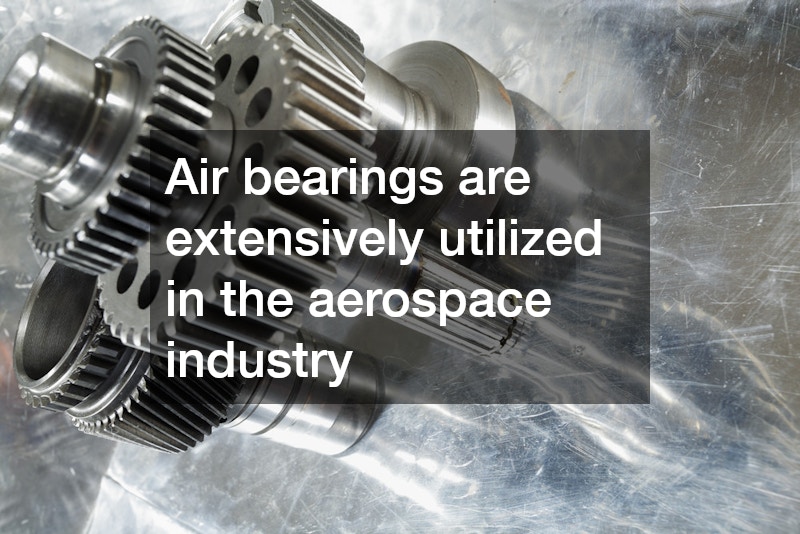
Air bearings, also known as aerodynamic or gas bearings, offer unique advantages in specific applications by utilizing a layer of air to provide virtually frictionless and maintenance-free motion. This article explores the circumstances and industries where air bearings are indispensable and elucidates the common queries surrounding their use.
Definition and Functionality
Air bearings function by creating a thin film of air between surfaces, providing a cushion that reduces surface-to-surface contact. This innovative technology employs a pressurized air system to maintain a consistent separation between the moving components, resulting in significantly reduced friction and wear.
These bearings eliminate the need for lubrication, which is often required in traditional bearings. The operational mechanism relies on the air cushion’s ability to absorb motion and vibrations, ensuring precise and smooth movement.
In high-speed applications, air bearings offer the benefit of noise reduction due to the lack of mechanical contact. This quiet operation coupled with the ability to handle high precision tasks makes them a suitable option for various industries.
Comparison with Traditional Bearings
Compared to conventional bearings, air bearings offer a frictionless operation, which enhances the efficiency and longevity of the mechanical systems they are part of. Traditional bearings, on the other hand, utilize physical contact to function, which inherently leads to wear and tear over time.
A major advantage of air bearings is their maintenance-free nature, unlike traditional bearings that require regular lubricating to operate effectively. Additionally, because air bearings operate without physical contact, they produce less heat, thereby extending the lifespan of the machinery.
One drawback of air bearings is the initial cost, which might be higher compared to traditional bearings. However, when factoring in the reduced maintenance and longer operational life, air bearings often prove to be more cost-effective in the long term.
Industrial Applications
Air bearings are extensively utilized in the aerospace industry, where precision and reliability are paramount. They play a crucial role in advanced manufacturing processes that require high-speed and high-precision machinery.
In the semiconductor manufacturing sector, air bearings contribute significantly to the precise positioning and handling of delicate components. Their ability to provide smooth and contact-free motion enhances the manufacturing process’s accuracy and repeatability.
Beyond aerospace and semiconductors, air bearings find applications in the medical equipment industry. The non-contact operation minimizes contamination risks, making them ideal for sterile environments.
Precision Instruments and Metrology
Air bearings are vital in the field of metrology, where precision and accuracy are essential. By utilizing air bearings, measuring instruments can maintain high precision without the degradation typically seen in systems with physical contact bearings.
Instruments such as coordinate measuring machines (CMM) and optical profilers benefit from the reduced friction and vibration damping provided by air bearings. This ensures that measurements remain consistent and reliable over time.
The longevity of air bearings is particularly advantageous for precision instrumentation, as it reduces the frequency and costs associated with recalibrating and replacing components. With air bearings, precision instruments can operate at optimal performance levels for extended periods.

Advantages in Performance
The primary reason for opting for air bearings is their superior performance characterized by near-zero friction. This results in smoother operations, reduced energy consumption, and higher overall efficiency.
High precision is another significant advantage, as air bearings provide stable and accurate movement necessary for sophisticated manufacturing and measurement tasks. The elimination of mechanical contact contributes directly to uninterrupted and reliable performance.
Another performance benefit is the ability of air bearings to dissipate heat effectively, enhancing the stability of high-speed operations. The minimal thermal expansion helps maintain exact tolerances even under variable conditions.
Longevity and Maintenance Benefits
Air bearings offer significant longevity benefits owing to their non-contact operation, which vastly reduces wear and tear compared to traditional bearings. This translates to less frequent maintenance needs and replacement costs.
By eliminating the need for lubrication, air bearings reduce the operational complexity and potential for failure associated with lubricant degradation or contamination. This makes them an ideal choice for systems requiring long-term reliability and minimal downtime.
While the initial cost of implementing air bearings might be higher, the reduced maintenance and extended operational life result in lower lifetime costs. Industries benefit from a cost-effective solution that enhances system reliability and availability.
Environmental Considerations
Dust and particulates present in the environment can interfere with the functioning of air bearings, potentially causing operational disruptions. As such, they may require clean environments or integrated filtration systems to maintain optimal performance.
Temperature variations can also impact air bearing effectiveness. While they are adept at handling slight fluctuations, extreme temperature changes can impact the air viscosity and, hence, the bearing’s performance.
Air bearings require a continuous supply of clean, filtered air to maintain their operation. This stipulation may limit their suitability in certain environments where such conditions cannot be guaranteed.
Technical and Cost Challenges
Technically, the design and implementation of air bearings can be complex, demanding precision engineering and advanced materials. This complexity can lead to higher initial costs and longer timeframes for development and integration.
While offering many operational benefits, the initial investment in air-bearing technology might be substantial, which can be a barrier for some organizations. However, the long-term savings and efficiency gains often justify the upfront expenses.
Retrofitting existing systems with air bearings can present challenges related to compatibility and integration. Businesses need to evaluate these aspects carefully to ensure seamless functionality and cost-effectiveness.
Air bearings offer substantial benefits across various industries, providing solutions that enhance performance while reducing operational costs and maintenance. By understanding their capabilities and limitations, industries can harness their full potential, leading to more efficient and advanced applications.





